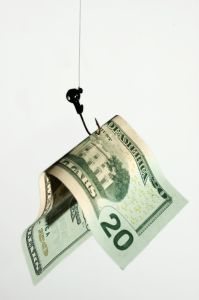You are no doubt familiar with the storefront payday lenders who have come under intense scrutiny from state and federal regulators critical of the practices that keep consumers in a seemingly endless cycle of debt.
A lot of people won’t even go near these stores for this very reason.
But you may not realize your bank could be doing the exact same thing – ie‚ handing out “emergency” loans that customers can’t afford and then charging them sky-high interest rates until they can repay them — or severe penalties if they can’t.
Our Woodland Hills bankruptcy lawyers understand that these kind of practices‚ known as “loan-sharking‚” have become common place at some of the country’s biggest financial institutions. According to a recent article by MSN Money Columnist Liz Weston‚ U.S. Bank‚ Fifth Third Bank‚ Regions and Wells Fargo all have some type of high-cost loans that end up leaving customers worse off than they were when they signed on the dotted line.
The banks‚ and even some consumers‚ say there can be benefits to a short-term credit service‚ even when pricey. Some say it’s a life-saver in a pinch.
And that may be true for some.
But consider that most consumers are paying anywhere from $15 to $20 on every $100 that they borrow‚ which breaks down to an annual interest rate of about 400 percent – sometimes more – just for a two-week loan.
The other problem is that for a lot of the people who are borrowing‚ the loans aren’t short-term. First off‚ they are using the loans not for some unanticipated‚ one-time expense‚ but rather for essentials such as gas‚ groceries and utilities. Once they get into a cycle of doing this once or twice‚ they soon fall into a situation where they can’t cover that post-dated loan on their next paycheck. So‚ they end up rolling over their loans until the next payday cycle – of course‚ for an additional fee.
The Center for Responsible Lending reports this often goes on for an extended period of time‚ with the average customer trapped in the cycle for about a 1.5 years‚ or through a cycle of nine transactions.
While it’s true that the payday loans offered by banks are a bit cheaper than the ones you will find at storefront venues‚ they will still run you an annual APR of somewhere between 225 and 300 percent.
The median bank payday loan borrower took out nearly 14 loans in 2011‚ and more than 33 percent took out more than 20 loans. According to research by the CRL‚ these borrowers were two times as likely to rack up overdraft fees and in most cases‚ they created more problems than they solved.
The Department of Defense‚ recognizing what a big problem these storefront venues were to military members‚ capped interest rates for active members at 36 percent. That was a huge blow to the industry‚ but they continue to thrive elsewhere across the country.
Most of the regulation that has been passed so far has been aimed squarely at those smaller‚ storefront lenders. But it is possible that could change‚ with the Consumer Financial Protection Bureau and the FDIC taking a closer look at how larger banks are able to sidestep certain state laws against high-interest loans using online channels.
Even if you feel confident that your payday loan debt isn’t holding you back‚ you should consider a consultation with an experienced bankruptcy lawyer if you routinely use this type of service for the basic necessities.
If you are contemplating bankruptcy in Woodland Hills‚ contact Cal West Law to schedule your free consultation. Call (800) 568-0707.
Additional Resources:
How big banks offer payday loans‚ April 19‚ 2013‚ By Liz Weston‚ MSN Money


